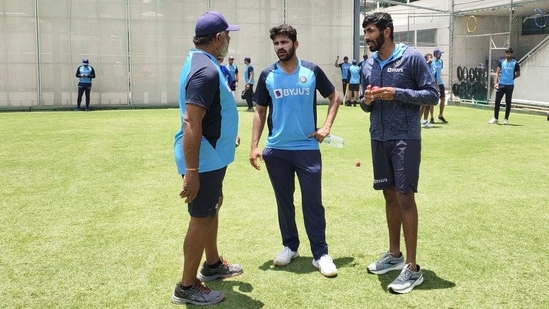From slower balls to yorkers: The art of bowling in T20s
Former India bowling coach Bharat Arun breaks down what works and what doesn't in the slam-bang format
Rashid Khan, Josh Hazlewood, Haris Rauf, Wanindu Hasaranga, Anrich Nortje, Adam Zampa and all the other top bowlers will have their skills put to the ultimate test in pressure situations by the best batters around at the upcoming T20 World Cup.

It's fascinating to see the pace at which the T20 format has led players to innovate. Given the pressure on the bowlers, more and more variations are being tried out, mastered and added to the armoury, in a bid to rein in the power hitters.
Apart from a mastery of your craft, it requires thinking on your feet for a quick reaction.
The pundits will be eagerly looking forward to what more the pacers and spinners bring to the table this time as the game keeps evolving.
From his vast experience of being an India bowling coach at previous T20 World Cups and being part of the IPL as the Kolkata Knight Riders’ bowling coach, Bharat Arun has a great understanding of the craft. He knows what it takes to be effective when the pressure is on.
Arun is not the one to be impressed by the talk of too many variations. It’s more about control in execution.
“The thing is to stick to your strengths, for a fast bowler to do well in T20 he must have a good length ball, a yorker, bouncer and a well-disguised slower ball. You needn’t have 10 variations but if you can execute these four balls at will, then you have the best chance to succeed,” says Arun as he breaks down the nuances of T20 bowling.
All the bowlers who are successful in T20 cricket at any stage either the powerplay, middle or the end overs, they have these four weapons. “Even if you don’t have the pace if your execution is good, you can still be a very effective bowler in T20," says Arun.
It’s about absolute consistency in execution. “Instead of a bowler trying to execute five different slower balls, ending up being a master of none of them, I would suggest whatever they can execute at will under pressure, I think they should stick to that. Not necessarily I have to showcase five different slower ones, one or two are more than enough to be successful," says Arun, who was India’s coach at the 2021 T20 World Cup held in UAE.
The key for variations to be effective is disguise. Bowling slower balls without giving obvious cues make it even more effective. It will help the bowler perform in any conditions. Because if you are giving cues that are obvious and with so much data available, it’s very easy for a batter to pick them up.
“A batter may be fooled once but he has the access to videos to find out the cue a bowler is giving before he bowls any particular ball. If it is (cue) quite evident then the batsman will look for those cues in the run-up or in loading.”
MINDSET
Moreover, T20 cricket is about mindset because sometimes even when your execution is perfect and have bowled a very good ball, the chances of that ball going out of the park are high.
For Arun, it's about sticking to your strengths no matter if your good balls are hit for a six.
“What eventually happens is whether I am going to back myself to bowl that ball again? The batter may get out trying to do so again, but my thinking also changes: 'I bowled a very good ball and this guy hit me out of the park, should I be bowling something else?'. Then you go away from your strengths. You try something which you are not very sure about, just because the batter has hit your strength out of the park. On the other hand, we have often seen the bowler repeat the same ball and the batter got out. The mindset is hugely important."
AWARENESS
The conditions will be very different from what the bowlers encountered in the last edition played in the UAE to Australia. For Arun, awareness of the conditions, ground and your own strengths, all these factors make you a consistent bowler. “On the quick pitch where the ball is coming on to the bat, he needs to take the pace off, on a slow pitch, instead of pitching it full, the balls which lose pace before reaching the batters have got better chances. This kind of awareness is important.
“When you come to Australia, the boundaries are far bigger, which gives license to the bowlers to work with. It is also very important to know the lengths you have to bowl.”
On grounds with bigger side boundaries what would be the go-to balls? “It would be bouncers and slow bouncers because I am asking the batter to target me on the bigger side of the boundary which I have better chance.”
If straighter boundaries are bigger, “Then I go more into length balls, yorkers and wide yorkers.”
NOTHING WORKS LIKE YORKERS
At one time, the yorkers were considered a sure-shot dot ball. The batters have become smarter in dealing with the toe-crushers now. For the bowling guru, yorker will always remain an effective delivery. “I am a big fan of yorkers. Very few batters around the world even if I tell them I am going to bowl a yorker, can dig it out and hit you out of the park. The pace doesn’t matter, any bowler who can execute the yorker well will be effective,” says Arun.
“I would rather go in for a high-performance (risk) ball like a yorker. If you look at the world’s best T20 bowlers you will find that all of them can execute the yorker at will and consistently. It is still the same. Let the batter try a scoop shot or whatever, if he misses, he is out. There’s a huge element of risk, I will still bat for a yorker.”
19TH OVER
In a tight game, the importance of the 19th over is not lost on anyone. For the bowling coach, a yorker-specialist is the best bet for the penultimate over of the match when defending a total. “When you bowl a really good yorker, the batter eventually gets a single as the fielders are also on the boundary. Bowling the length ball is a mistake. The length ball gives a batter the chance to get under the ball and hit you for a six. Suppose the equation is 22 to win: when you bowl yorkers and even concede a boundary, you give away 9 runs. I would rather bowl yorkers in the 19th over. In the final over if you need 9 runs, what is the point in bowling yorkers?
“In the 20th over I rather go for the length balls and bouncers, because while going for a hit the batter may get out. Eight-nine runs are very difficult to block by bowling yorkers because anywhere I tap I get a single whereas with a length ball you could miss. It gives the best chance for you to succeed.”
Bowling in Australia
Variations can be the same everywhere, but the lengths you want to bowl and the pace at which you want to bowl would be different in Australia. “In India sometimes the wickets could be a little slower and the ball doesn’t really come on to the bat. In Australia, there is bounce so the length where you want to pitch varies a little bit. Also, every wicket is different so how quickly a bowler adapts is the challenge. The bowlers will have to keenly watch the initial period of play and understand how the pitch is behaving. If it is on the slower side we try and get them to drive so that it doesn't come onto the bat, if the straight boundary is big, the yorkers can be used effectively because it is difficult to clear the ground. All these factors come into play and how quickly you adapt to the existing conditions is the biggest challenge for any bowler and coach.”
All Access.
One Subscription.
Get 360° coverage—from daily headlines
to 100 year archives.



HT App & Website







